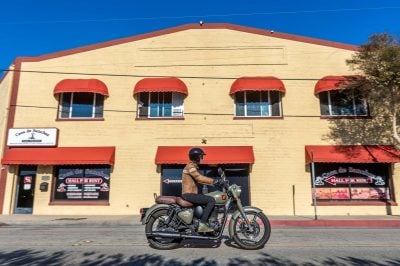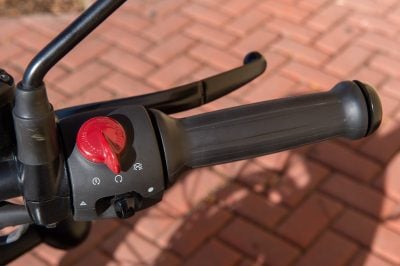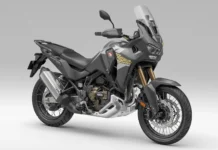On the heels of last year’s successful entrance to the US market by the cruiser-style Meteor 350, Royal Enfield brings us another small displacement motorcycle in the form of the Classic 350. The new 2022 Royal Enfield Classic 350, which shares its engine with the Meteor, recalls the much-loved Bullet, thanks to its feel-good nostalgia and a yester-year simplicity that everyone can appreciate.
- The 2022 Royal Enfield Classic 350 has old-school standard ergonomics. Straddling a Classic 350 takes no getting used to. While the 31.7-inch seat height is just over an inch and a half taller than the low-slung Meteor, it doesn’t feel tall. Credit the wide bars, upright seating position, and compact rider triangle for an unintimidating first-date experience. The bike has a manageable feel to it.
- Thanks to a clutch with a broad engagement sweep, the Classic 350 couldn’t be any easier to operate unless it was automatic. Dealers tell us the Classic 350 is drawing new riders into Royal Enfield’s showrooms, and many of them will likely never have operated a standard transmission car. Learning to manage a clutch, especially on two wheels, can be daunting. However, the 350’s clutch is newbie-friendly. Although the clutch pull is not particularly light for the small displacement engine, it engages so gradually that it is easy on the uninitiated and lessens the likelihood of stalling.
- The transmission is as smooth as the clutch. There is no clunk, or even a click. Riders will need to learn to have a clean follow-through when shifting from 1st to 2nd gear. I hit unintended neutral several times before I cleaned up my sloppy shifting.
- The 349cc long-stroke vertical single is torquey and slow revving, perfect for fun rides and avoiding mishaps. The air-cooled motor produces 20 ft-lbs of torque at an easily accessed 4000 rpm. That’s enough pull to get you off the line in front of most cars. The Classic 350 isn’t about speed or nimble moves. Newer riders will find a lot of grace with the 350 powerplant. It’s easy to ride, forgiving, has spunk, and willingly takes you over just about any paved road condition surefootedly.
- Shift up for the clearest view in your mirrors, as they are fuzzy at almost all engine speeds. About the only time I get a clear view in the mirrors is when I’m at low rpm in 5th gear, just on the edge of lugging.
- The brakes are absolutely perfectly dialed for the Classic 350 rider. Engagement is so soft, I don’t think it’s possible to grab the brake lever hard enough to scare yourself. At the same time, there’s enough braking power in the single front disc that a firm squeeze will slow the bike appropriately. The rear brake is equally relaxed while still being useful. The 350 has dual-channel ABS, so using the front or rear brake separately will automatically engage the ABS if you lock the wheel. It took a heavy foot to deliberately trip the ABS, so the system is non-intrusive.
- When it’s time to decelerate, the EFI system has an odd glitch. When letting off the throttle to slow down for a red light, instead of stopping all fueling, the throttle feels like it’s a neutral throttle for a few moments before fully shutting off the fuel flow. It’s unnerving until you get used to it—a closed throttle should mean closed throttle immediately. Although the Classic 350 is new to the North American market, over three million units have been sold internationally—plenty of time to work out any EFI issues. Perhaps it’s an anomaly specific to the bike we tested. Engine compression braking is good, especially when supplemented by a downshift.
- At 430 pounds, the 2022 Royal Enfield Classic 350 is heavy—66 pounds more than the Honda Rebel 300. Despite its weight, the Classic is quite maneuverable at slow speeds. The 350 is far from being a handful, fortunately. The wide bars, upright seating, and easy-going power delivery are the secret to its stress-free operation. I can easily paddle the bike into position when parking, as there is plenty of leverage at the bars. Some of that extra weight can be attributed to the centerstand, which has the desirable side effect of lowering the center of gravity.
- The non-adjustable suspension does a good job in a wide variety of conditions. You get just over five inches of travel from the 41mm fork, and soft action handles LA’s rough and tumble street conditions well. The 19-inch front wheel helps the 350 roll over bumps and ripples in the road. The old-school twin shocks similarly soak up the worst of the road irregularities, and the thick, soft solo seat contributes to a comfortable ride (our test bike had an accessory pillion). Although you’re certainly aware of the condition of the road on the 350, you don’t have to tiptoe over the rough stuff.
- The Ceat tires are perfectly suited to the Classic 350’s intended use. Indian-based Ceat may not be a familiar brand in the U.S., but the Zoom Plus rubber was inspiringly confident on the street, in twisty conditions in the hills, and flat-out on the freeway.
- Although the 2022 Royal Enfield Classic 350 has enough speed for the freeway, it’s not your best choice for a long-distance commuter. The long-stroke single can pull over 70 mph, just enough to keep up with the aggressive traffic on Los Angeles freeways if you stay out of the left lanes. That doesn’t leave you with anything extra if you need to make a quick move or the road is even slightly uphill. A soft rev-limiter kicks in around 75 mph, even on downhill grades. It’s fine for commuting on local urban freeways where the speed limit is 55 mph.
- The Classic 350 proves you don’t need a sport bike to have fun sprinting through the hills. Tight two-lane roads, such as LA’s famed Mulholland Drive and Whittier’s short-but-sweet Turnbull Canyon Road, are perfect playgrounds for the 350’s torquey, steady-handling personality. I can push into corners confidently, using leverage from the upright seating position to turn the Classic, and accelerate out as fast as the 350 allows—which isn’t fast. The front end doesn’t waver, with the Ceat 19-inch tire performing admirably. There is plenty of cornering clearance for a sporty lean. It doesn’t take high speeds to build adrenalin and have a total blast; a willing, smaller engine with a predictable response allows you to enjoy all of the bike’s power instead of managing half of it.

- On high-speed sweepers, you’ll notice the Classic 350’s limitations. While the 350 can credibly keep up with a larger displacement bike in tight conditions, you will quickly fall behind once the road opens up. Fast runs are not the 350’s raison d’être. It is worth noting how stable the Classic feels at the speeds it can achieve, and how well the suspension handles rugged real-world backroads. The planted feel provides plenty of confidence in the motorcycle.
- The basic old-school dash looks just right for the Classic 350. The dash is dominated by the sweeping analog speedometer, while a small LCD screen underneath continually displays the fuel gauge. Pushing the small round button on the back side of the left-hand switchgear scrolls between trips, time, or odometer. The round ignition/kill switch and high/low and passing light switch on the handlebar fit right in with the styling of the Classic.
- Speaking of styling, our test bike had the distinctive military-inspired Signals livery. It’s patterned after the parachute-deployed Flying Flea used by the Brits in WWII. The “TP 28” stencil on the rear fender was intended to tell troops the proper tire psi—that’s just a graphic, not an instruction for the modern Classic 350. The other stickers are stylized illustrations, not replicas of designs used by the military; you don’t have to tell anyone at the Coffee Bean that. A custom touch is the stenciled numbers on the tank—it’s unique to each bike. Also, although our test bike looks quite green, its official colorway name is Signals Marsh Grey.
- There are 10 different color/trim options for the Classic, and they change the presentation of the motorcycle dramatically, particularly when seen in person. I was immediately taken by the Halcyon Blue—a perfect girls’ color, though I’m probably not supposed to say that. When we dropped off the test bike at Southern California Motorcycles, a customer was taking delivery of the Halcyon Forest Green version, which looks sharp.
- The 2022 Royal Enfield Classic 350’s everyday practicality makes it appealing for a wide variety of uses. With a friendly power delivery, neutral handling, and approachable ergonomics, it’s a perfect platform for new riders to hone their skills. For seasoned riders, the Classic 350 is a relaxed, vintage-style ride that evokes simpler times and looks great wherever you park it.
Photography by Don Williams
RIDING STYLE
- Helmet: Bell Custom 500 w/ 3-Snap Retro Visor
- Sunglasses: Wiley X Captivate WX Grid
- Jacket: Joe Rocket Ladies Classic ’92
- Back Protection: Alpinestars Nucleon KR-1
- Gloves: Racer Gloves USA Women’s Comfort 2
- Jeans: Alpinestars Daisy V2
- Shoes: Alpinestars Jam Air
2022 Royal Enfield Classic 350 Specs
ENGINE
- Type: Vertical single
- Displacement: 349cc
- Bore x stroke: 72 x 85.8mm
- Maximum power: 20 horsepower @ 6100 rpm
- Maximum torque: 20 ft-lbs @ 4000 rpm
- Valvetrain: SOHC; 2 valves
- Fueling: EFI
- Cooling: Air
- Transmission: 5-speed
- Final drive: Chain
CHASSIS
- Frame: Twin downtube spine
- Front suspension; travel: Non-adjustable 41mm fork; 5.1 inches
- Rear suspension: Spring-preload adjustable twin-tube emulsion shocks
- Wheels: Wire-spoke (Dark models have aluminum wheels)
- Tires: Ceat Zoom Plus
- Front tire: 100/90 x 19
- Rear tire: 120/80 x 18
- Front brake: 300mm disc w/ 2-piston floating caliper
- Rear brake: 270mm disc w/ single-piston floating caliper
- ABS: Dual-channel standard
DIMENSIONS and CAPACITIES
- Wheelbase: 54.7 inches
- Seat height: 31.7 inches
- Fuel capacity: 3.4 gallons
- Curb weight: 430 pounds
2022 Royal Enfield Classic 350 Prices
- Halcyon Black: $4599 MSRP
- Halcyon Forest Green: $4599
- Halcyon Blue: $4599
- Signals Marsh Grey: $4699
- Signals Desert Sand: $4699
- Chrome Red: $4799
- Chrome Bronze: $4799
- Dark Gunmetal Grey: $4799
- Dark Stealth Black: $4799
2022 Royal Enfield Classic 350 Review Photo Gallery
































![2024 Suzuki V-Strom 800 Touring First Look [Fast Facts + Photos] 2024 Suzuki V-Strom 800 Touring First Look: MSRP](https://ultimatemotorcycling.com/wp-content/uploads/2023/10/2024-suzuki-v-strom-800-touring-first-look-3-218x150.webp)
![2023 Motocross of Nations Results, Video [France Dominates] 2023 Motocross Of Nations Results](https://ultimatemotorcycling.com/wp-content/uploads/2023/10/2023-motocross-of-nations-start-218x150.jpg)

